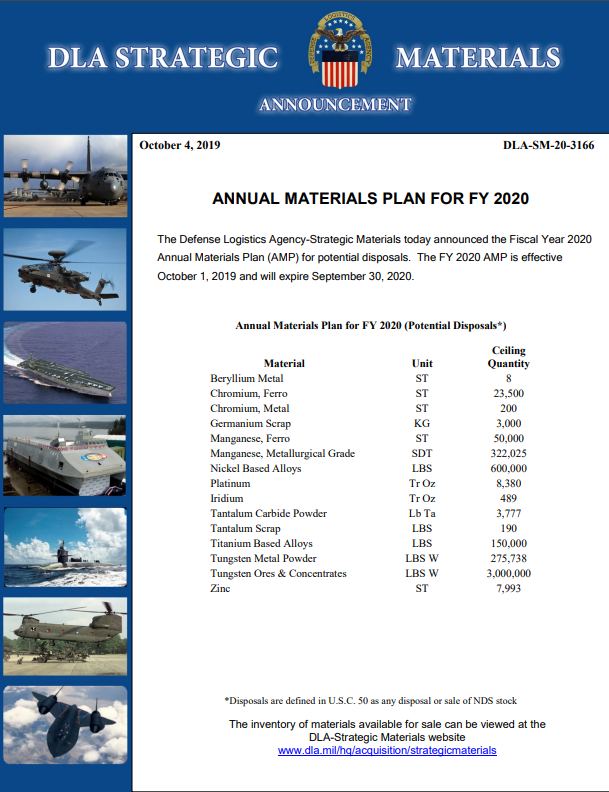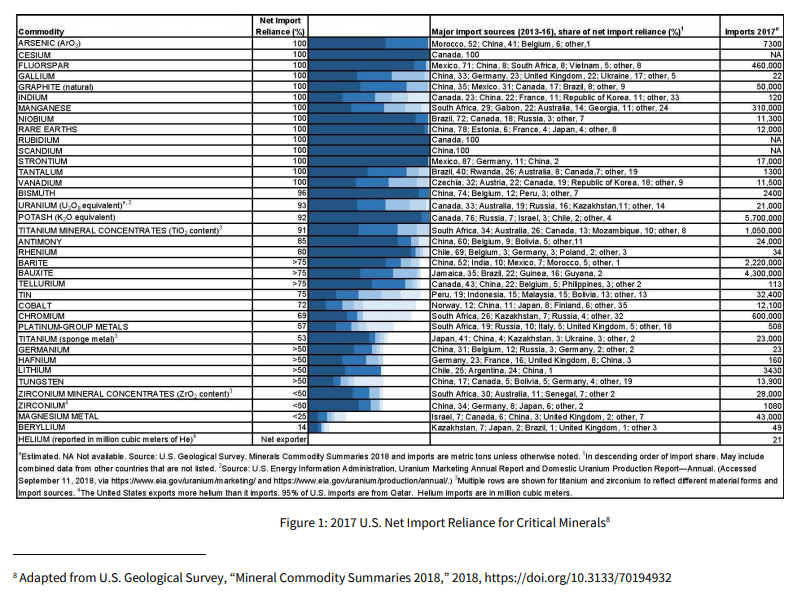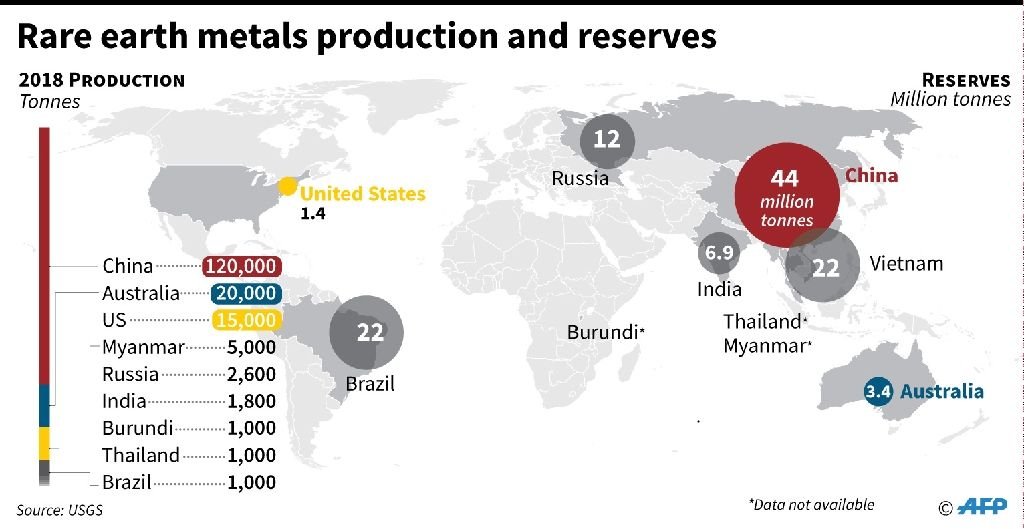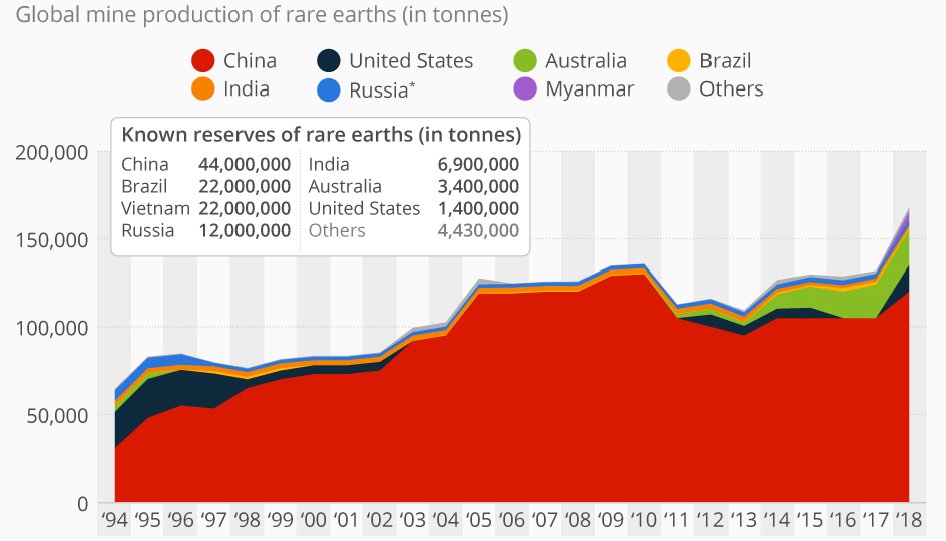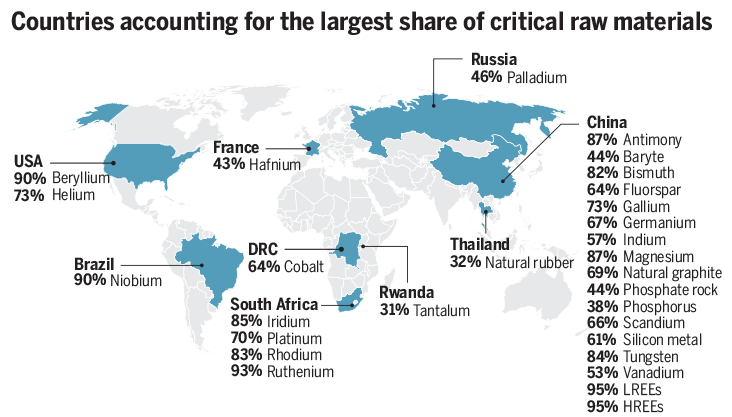𝐓𝐡𝐞 𝐅𝐨𝐮𝐧𝐝𝐚𝐭𝐢𝐨𝐧 𝐨𝐟 𝐓𝐨𝐦𝐨𝐫𝐫𝐨𝐰
The United States and China have taken wildly differing approaches to securing their individual national security.
A key distinction - and one where China is leading - is in control of critical raw materials.
Thread.
The United States and China have taken wildly differing approaches to securing their individual national security.
A key distinction - and one where China is leading - is in control of critical raw materials.
Thread.
In 1939, Pres Roosevelt signed the Strategic and Critical Materials Stock Piling Act into law.
Its intent was to prevent the US from being caught short of essential raw materials during a crisis, especially where the US had dependency on foreign sources.
We have failed.
2/
Its intent was to prevent the US from being caught short of essential raw materials during a crisis, especially where the US had dependency on foreign sources.
We have failed.
2/
Critically, the Act specifically constrains stockpiling to those essential items that defense materiel managers needed for ammunition, fuel, vehicles, and so on.
In 1954, Congress amended the law to include reserves of grain (also aiding in farm price supports).
3/
In 1954, Congress amended the law to include reserves of grain (also aiding in farm price supports).
3/
Today, the National Defense Stockpile (NDS) is comprised of 42 materials, and is managed by the Defense Logistics Agency.
Each year, the DLA rotates inventory through sales or disposal of in-stock materials, depending on changes suggested bi-annually by the Dept of Defense.
4/
Each year, the DLA rotates inventory through sales or disposal of in-stock materials, depending on changes suggested bi-annually by the Dept of Defense.
4/
Recommendations for materials to be included/excluded from the NDS are made by the Institute for Defense Analyses, a contractor for the Defense Logistics Agency.
Recommendations from IDA roll up to SecDef, who approves and presents the requirements to Congress biannually.
5/
Recommendations from IDA roll up to SecDef, who approves and presents the requirements to Congress biannually.
5/
The materials requirement process is built around three pillars with input from four groups:
1. Military forecasting
2. Economic models
3. Domestic supply vs reliable foreign sources
Anything deemed to be critical to future mil needs and not easily available is stockpiled.
6/
1. Military forecasting
2. Economic models
3. Domestic supply vs reliable foreign sources
Anything deemed to be critical to future mil needs and not easily available is stockpiled.
6/
Important to note is that the worst-case anticipated scenario is two major wars, an attack on a US city, and a smaller disaster, all occuring within 12 months.
The modeling does not account for things like sources being co-opted by adversaries, or pandemic-level events.
7/
The modeling does not account for things like sources being co-opted by adversaries, or pandemic-level events.
7/
The strategy-minded reader will note that this is a defensive posture, rooted in static assumptions.
The NDS is not treated as a strategic weapon, except to the extent that it equips the defense-industrial base to keep making materiel during a major supply chain disruption.
8/
The NDS is not treated as a strategic weapon, except to the extent that it equips the defense-industrial base to keep making materiel during a major supply chain disruption.
8/
This also reflects the US' reliance on private industry and traditional trading practices to maintain readiness and safety stock for the arsenal of democracy.
We make it here, or we buy it somewhere else.
In a sense, the NDS operates as a big commodities brokerage.
9/
We make it here, or we buy it somewhere else.
In a sense, the NDS operates as a big commodities brokerage.
9/
Incredibly, given the size of the US' defense-industrial base and $700+ billion annual defense budget, the NDS currently holds only about $1.1B in materials on-hand scattered across 6 facilities.
Further, the DOD does not always agree with itself on what must be stockpiled.
10/
Further, the DOD does not always agree with itself on what must be stockpiled.
10/
A 2016 audit of NDS management of rare earth materials by the GAO (GAO-16-161) found that three of the DOD agencies with inputs into the process came up with five different lists of required materials and stockpile need.
Nor are system-specific needs reported accurately.
11/
Nor are system-specific needs reported accurately.
11/
Contra the US' byzantine process, China has taken a more holistic approach to strategic materials:
Since 1990, China has been at war for strategic materials.
"Made in China 2025", announced in 2016, supercharged these efforts.
12/
Since 1990, China has been at war for strategic materials.
"Made in China 2025", announced in 2016, supercharged these efforts.
12/
The Belt and Road Initiative, launched in 2013, is the backbone of this project.
With billions of dollars in infrastructure loans, private industry investment, and state owned enterprise activity, the CCP has rapidly reoriented global supply chains.
13/ https://twitter.com/man_integrated/status/1192489639547936768
With billions of dollars in infrastructure loans, private industry investment, and state owned enterprise activity, the CCP has rapidly reoriented global supply chains.
13/ https://twitter.com/man_integrated/status/1192489639547936768
The primary way China ties BRI and mineral acquisition together is "resource-backed loans".
China will invest money into infrastructure, schools, and the local economy, in exchange for mineral rights and exclusive offtake (purchase) agreements.
14/ https://www.reuters.com/article/commodities-loans-africa-americas/chinese-commodity-backed-loans-crippling-africa-and-latin-america-report-idUSL5N2AP3NL
China will invest money into infrastructure, schools, and the local economy, in exchange for mineral rights and exclusive offtake (purchase) agreements.
14/ https://www.reuters.com/article/commodities-loans-africa-americas/chinese-commodity-backed-loans-crippling-africa-and-latin-america-report-idUSL5N2AP3NL
This 2015 article from the SCMP illuminates how China coopted a tiny nation rich in a single resource (bauxite), just to vertically integrate Chinese aluminum supply chains.
Today, bauxite is 60% of Guinean exports - China is the primary buyer.
15/ https://www.scmp.com/business/commodities/article/1751948/china-hongqiao-close-clinching-bauxite-deal-guinea
Today, bauxite is 60% of Guinean exports - China is the primary buyer.
15/ https://www.scmp.com/business/commodities/article/1751948/china-hongqiao-close-clinching-bauxite-deal-guinea
Why would China go to such trouble for bauxite (as an example)?
It's the essential raw material to make alumina, which makes aluminum, one of the most used materials worldwide.
Further, gallium is a coproduct of the refining process.
16/ https://twitter.com/man_integrated/status/1203053464902918145
It's the essential raw material to make alumina, which makes aluminum, one of the most used materials worldwide.
Further, gallium is a coproduct of the refining process.
16/ https://twitter.com/man_integrated/status/1203053464902918145
China is also adept at using corporate structures to its advantage.
Consider the acquisition in 2019 of 24% of Chile's SQM by a Chinese company.
SQM is the dominant player globally in lithium (key component of batteries), and a major producer of fertilizers.
Strong move.
17/
Consider the acquisition in 2019 of 24% of Chile's SQM by a Chinese company.
SQM is the dominant player globally in lithium (key component of batteries), and a major producer of fertilizers.
Strong move.
17/
Even in the US, China has control of the only active rare earth supply chain, the former Molycorp mine at Mountain Pass, CA.
Though two US private equity firms run the mine's operations, it's China's Shenghe Group that owns the offtake rights to all 50K tons/yr.
18/
Though two US private equity firms run the mine's operations, it's China's Shenghe Group that owns the offtake rights to all 50K tons/yr.
18/
The argument that "rare earths aren't that rare" is off the mark.
It's true that they're abundant, but NOT in economically-viable concentrations that can be extracted.
China knows this, and has been gobbling up those few viable sources of rare earths - including ours.
19/
It's true that they're abundant, but NOT in economically-viable concentrations that can be extracted.
China knows this, and has been gobbling up those few viable sources of rare earths - including ours.
19/
This is hybrid political/economic warfare by the most unconventional means.
It's also the key part that most armchair observers miss when they dismiss China as a paper tiger.
Quite simply, China has made too many nations dependent on it, making full decoupling impossible.
20/
It's also the key part that most armchair observers miss when they dismiss China as a paper tiger.
Quite simply, China has made too many nations dependent on it, making full decoupling impossible.
20/
Notably, China has been heavily targeting critical raw materials for telecom, semiconductors, satellites, batteries, solar cells, and weapons systems.
The US is moving shamefully slowly to address China's first mover advantage - and every year we fall more behind.
21/
The US is moving shamefully slowly to address China's first mover advantage - and every year we fall more behind.
21/
This is where weaponized logistics comes in.
BRI is increasingly earning a bad rap as "debt diplomacy", which caused the US, Australia, and Japan to cooperatively launch the Blue Dot Network to counter BRI in NOV19.
But the immature BDN is not enough.
It must go deeper.
22/
BRI is increasingly earning a bad rap as "debt diplomacy", which caused the US, Australia, and Japan to cooperatively launch the Blue Dot Network to counter BRI in NOV19.
But the immature BDN is not enough.
It must go deeper.
22/
First, the US must completely shift its policy and structure around strategic materials. These are weapons in a time of war, and as we're seeing with COVID-19, foreign dependency is dangerous.
This proposal from the Dept of Commerce is a first step.
https://www.commerce.gov/sites/default/files/2020-01/Critical_Minerals_Strategy_Final.pdf
23/
This proposal from the Dept of Commerce is a first step.
https://www.commerce.gov/sites/default/files/2020-01/Critical_Minerals_Strategy_Final.pdf
23/
Second, the US must implement a sub-Cabinet level National Quartermaster to streamline visibility and accountability for strategic materials, as well as food, water, energy supplies (including clean-tech), and medical goods.
This role will also be key to the success of BDN.
24/
This role will also be key to the success of BDN.
24/

 Read on Twitter
Read on Twitter

